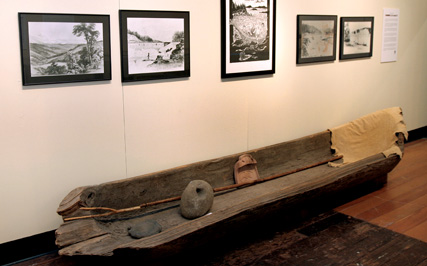Culture
Canoe exhibit honored with award of merit

The revival of traditional canoe culture in Grand Ronde was honored recently by the nation's leading history museum association.
The Tribe and Willamette Heritage Center at the Mill won the 2012 Award of Merit from the Nashville-based American Association of State and Local History for the "Grand Ronde Canoe Journey" exhibit.
The exhibit was displayed at the Willamette Heritage Center in Salem during April and May 2011. The exhibit came out as the top entry for recognition in the association's Leadership in History program.
David Lewis, manager of the Tribe's Cultural Resources Department, said the award "means we are doing good work, and the local community is beginning to recognize and understand the importance of the cultural work occurring.
"We were asked to submit (this exhibit to the AASLH) by the Oregon Parks and Recreation Department, so people are getting what we are doing. This is important because 10 years ago, few Oregonians knew we had a living culture."
"This exhibit is really fulfilling the mission of Willamette Heritage Center," said Executive Director Peter Booth. "We are dedicated to bringing out the heritage of the peoples in the valley. It's a big job. And part of it is to eke out partnerships that are going to help us do that. This partnership is exactly what we envisioned when we set out on our mission: Better preserving the story and the heritage, and bringing them to the larger community."
The Nashville association appreciated the exhibit for three reasons, Booth said.
"Number one: They really enjoyed the fact that this was a cooperative exhibit and project between two cultural entities - the Tribe and the museum.
"Number two: They looked favorably on the effort of this exhibit to recreate a part of the culture that had faded from recent memory -- the carving of the shovel-nosed canoe.
"And number three: The significance of that impressed them. The exhibit highlighted an aspect of Native American culture that had not been highlighted elsewhere. The significance of the exhibit was that it was bringing to the larger community the story of river canoes that used to ply up and down the Willamette and other rivers, as opposed to the more well-known ocean-going, Chinook-style canoes. They got that and recognized that, and wanted to applaud it."
The process of carving the canoe was an education for Cultural Education Specialist Brian Krehbiel.
"We came across every obstacle I think you can come across when carving a canoe," Krehbiel said, from heart rot to bug holes. The carvers went back to pictures of river-going canoes from the area, but the question still remained, "Where is this style of canoe going to start and stop at?" he said. "It kind of looks like this, but what's that part and where is it from?"
With carvers like Tribal Elder Robert Watson, "one of the most dedicated carvers," Krehbiel said, "there were lots of ideas we bounced off each other to do this. Same with Travis (Mercier), Bobby (Mercier) and Richard (Bubba) Sohappy, who took a lot of pictures and helped us mark this event."
The Tribe already had ocean-going canoes, but carving the river-style canoe "brought us a little closer (to who the Grand Ronde people are)," Krehbiel said.
"The maps were a great success, and received very well," said David Harrelson, Culture Protection specialist, who researched the maps and produced them in collaboration with Tribal Graphic Design Specialist George Valdez. "The maps provided a strong visual connection for the Tribe to our ceded lands, and they were also successful in communicating our Tribe's connection to our rivers and a canoeing tradition."
Kudos for the exhibit go to many on Tribal staff, including curator Julie Brown, community canoe carvers led by Krehbiel and Mercier, mapmakers Harrelson and Valdez, Cultural Resources Secretary Veronica Montano and Tribal GIS Coordinator Volker Mel, and at Willamette Heritage Center to Booth and staff member Keni Sturgeon.
Krehbiel also singled out Tribal Elder Don Day for his advice on traditional methods for splitting the log ultimately carved into the Kalapuya-style river canoe, and Darrell Pepper for making the plugs that filled the many holes found in the split cedar body of the canoe.
"Tribal Elders and members of the Tribal community shared knowledge, gave time and helped in many ways to make all this possible," said Lewis. Thanks also go to Tribal Council and the Willamette Heritage Center at The Mill for helping finance the exhibit, he said.
The exhibit served two purposes, Lewis added.
"I think it's significant," he said, "as we planned the exhibit to not only tell the story of the restoration and the revival of canoe culture, but also as a part of that recovery. The exhibit became a vehicle for the recovery portion that involved development of advanced carving projects at the Tribe, which were centered around the carving of the Kalapuya river canoe, so the exhibit was part of the cultural restoration occurring."
